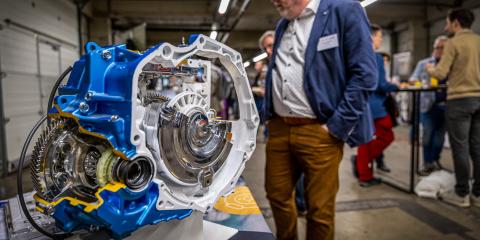Circular mobility shifts up a gear

On 25 February, Circuit Zolder was not about the fastest lap time, but about the acceleration towards circular mobility. During the ‘Circular Vehicle Solutions’ event, organised by POM Limburg, Flanders Make, Agoria and Amac, experts and companies came together to roll out the green carpet for the automotive sector of the future. One thing was certain: the way forward is ... a roundabout.
For 26 years, Febelauto has been coordinating the recycling and treatment of end-of-life vehicles in Belgium. ‘With 98% material recovery, we set the standard in Europe,’ opens director Catherine Lenaerts. ‘But circular mobility goes beyond recycling: 23% of an end-of-life vehicle is effectively reused, from engine components to chassis. That's very much compared to other sectors.’
That circular approach is becoming increasingly important as the number of end-of-life EV batteries increases sharply. ‘The volume of batteries collected is doubling every year,’ Catherine further explains. ‘This requires specialised processing and safe storage, as many batteries are in critical condition. Nevertheless, last year we were able to reuse or recycle 85% of EV batteries.’
Reuse of second-hand parts
Not only batteries, but also used EV parts are rapidly gaining importance. ‘Manufacturers can significantly reduce their carbon footprint by reusing parts,’ Catherine says. ‘Foreign recycling companies are cleverly capitalising on this with digital platforms where you can buy these parts. This leads to fierce competition, but at the same time strengthens the transition to a more sustainable sector.
For its part, Europe is playing an active role by imposing new rules on car manufacturers, including on the reuse of materials and stricter traceability of batteries and parts. ‘This prevents illegal trade and forces the automotive sector to design in a truly circular way. Only then will we come full circle together.’
Regulations as a driver
So good supervision from Europe. It is something that Els Fonteyne, circular economy expert at Agoria, would also like to see happen. ‘The EU Green Deal aims for climate neutrality by 2050, but only by separating growth from resource consumption can you create a sustainable circular economy.’ The Circular Economic Action Plan (CEAP) and the Ecodesign Sustainable Products Directive (ESPR) are key legislations that encourage sustainable product development. ‘The focus today is not only on recycling, but also on extending product life, repair and reuse,’ Els explains. ‘We need to design products that last longer and are easy to repair.’
Circular vehicle passport
The digital product passport should contribute to this by providing detailed information on the composition, repair and reuse of products such as textiles and electronics. ‘It makes circular design transparent and accessible, also for consumers,’ she says.
For batteries, this passport will be mandatory from 2027, but there is also a proposal on the table to create a circular vehicle passport. This should ensure that all essential information on the composition, reusability and recycling of vehicles becomes transparent. ‘A gamechanger for the sector, although the proposal has not yet received final approval,’ Els points out.
AI behind the wheel
And what about the transition to autonomous driving? Jeroen van der Werf, Manager Smart Mobility at VDL Enabling Transport Solutions already sees a promising future. ‘Self-driving transport is becoming increasingly relevant, not only to reduce emissions, but also as an answer to the growing shortage of bus and truck drivers,’ he says. ‘The sector is already struggling with a huge number of vacancies, and that number threatens to double by 2028.’
Self-driving vehicles as a solution, then. In theory? Or also already in practice? ‘We are currently experimenting with autonomous technologies in defined areas, such as bus depots or logistics zones, where vehicles can manoeuvre independently. In a next step, these could be separate lanes in traffic, in which self-driving buses and trucks drive.’
Positive forecasts
Technology offers huge opportunities, but ultimately it is also about economic returns. ‘Without a financially viable solution, it remains just a good idea. However, the figures are rosy.’ For instance, automated public transport could save 50% by 2030. In freight transport, too, self-driving trucks could reduce fuel consumption, empty runs and operational costs.
‘The first deployments will reveal not only the opportunities but also the challenges. The faster we take this step, the faster we can adjust and improve,’ Jeroen concludes.
New mindset
In a concluding panel discussion, experts reiterated that the only way forward is circular. The mindset in the automotive sector is clearly changing. ‘Where recycling was hardly on the radar before, it is now becoming an asset. More and more brands, think Mercedes and BMW, are using recycled materials as a marketing strategy to highlight their new models. This is a positive evolution,’ Catherine says.
‘Although we need to look beyond recycling alone,’ adds Els. ‘Car sharing, for example, increases the intensity of use of cars, allowing us to do more with fewer materials. Instead of owning one car that sits idle 90% of the time, people can use a vehicle that suits their needs at the time - small for commuting, bigger for family trips. This opens the door to innovative vehicle concepts and more sustainable mobility.’
The conclusion already sounded unequivocal. ‘The future? That rides on circularity.’
